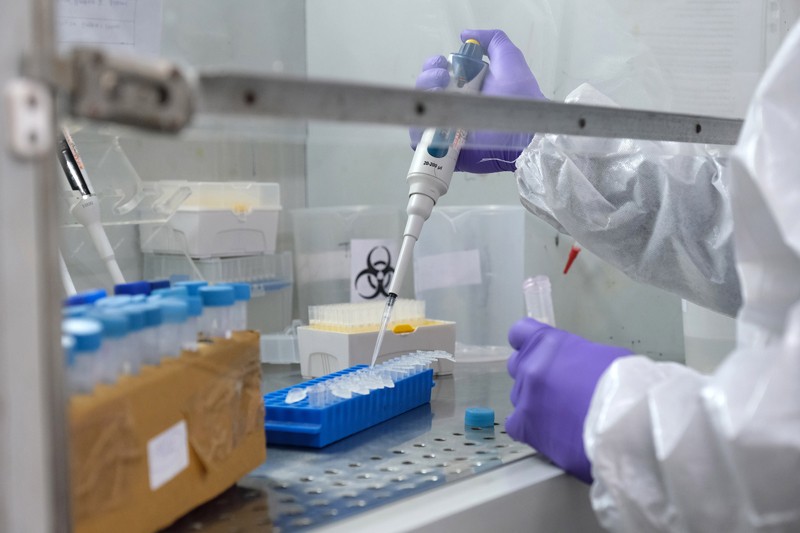the story of the variant that wasn’t
On 7 January, virologist Leondios Kostrikis announced on local television that his research group at the University of Cyprus in Nicosia had identified several SARS-CoV-2 genomes that featured elements of both the Delta and Omicron variants.
Named by them as ‘Deltacron,’ Kostrikis and his team uploaded 25 of the sequences to the popular public repository GISAID that evening, and another 27 a few days later. On 8 January, financial news outlet Bloomberg picked up the story, and Deltacron became international news.
The response from the scientific community was swift. Many specialists declared both on social media and to the press that the 52 sequences did not point to a new variant, and were not the result of recombination — the genetic sharing of information — between viruses, but instead probably resulted from contamination in the laboratory.
“There is no such thing as #Deltacron,” tweeted Krutika Kuppalli, a member of the World Health Organization’s COVID-19 technical team based at the Medical University of South Carolina in Charleston, on 9 January. “#Omicron and #Delta did NOT form a super variant.”
Spread of misinformation
The story behind how a small crop of SARS-CoV-2 sequences became the focus of a brief and intense scientific controversy is complicated. And although some researchers applaud the system for quickly catching a possible sequencing error, others warn that the events of last week may offer a cautionary tale on the spread of misinformation during the pandemic.
Kostrikis says that aspects of his original hypothesis have been misconstrued, and that — despite the confusing name that some of the media took to mean that the sequences were those of a Delta–Omicron recombinant virus — he never said that the sequences represented a hybrid of the two.
Nevertheless, 72 hours after the researchers uploaded the sequences, Kostrikis removed them from public view on the database, pending further investigation.
Cheryl Bennett, an official at the GISAID Foundation’s Washington DC office says that, as more than 7 million SARS-CoV-2 genomes have been uploaded to the GISAID database since January 2020, some sequencing mistakes should not come as a surprise.
“However, rushing to conclusions on data that have just been made available by labs that find themselves under significant time pressure to generate data in a timely manner is not helpful in any outbreak,” she says.
An error in the sequence?
The ‘Deltacron’ sequences were generated from virus samples obtained by Kostrikis and his team in December as part of an effort to track the spread of SARS-CoV-2 variants in Cyprus. While examining some of their sequences, the researchers noticed an Omicron-like genetic signature in the gene for the spike protein, which helps the virus to enter cells.
In an e-mail to Nature, Kostrikis explains that his initial hypothesis was that some Delta virus particles had independently evolved mutations in the spike gene similar to those common in Omicron. But after the wide news coverage, other scientists working on genetic sequencing and COVID-19 pointed out another possibility: a lab error.
Sequencing any genome depends on primers — short bits of manufactured DNA that serve as the starting point for sequencing by binding to the target sequence.
Delta, however, has a mutation in the spike gene that reduces some primers’ ability to bind to it, making it harder to sequence this region of the genome. Omicron doesn’t share this mutation, so if any Omicron particles were mixed into the sample owing to contamination, it might make the sequenced spike gene seem to be similar to that in Omicron, says Jeremy Kamil, a virologist at Louisiana State University Health Shreveport.
This type of contamination, says Kamil, is “so, so common”.
Kostrikis counters that if Deltacron was a product of contamination, sequencing should have turned up Omicron sequences with Delta-like mutations, as Omicron has its own primer-hindering mutation. He adds that the Deltacron lab contamination argument was “spearheaded by social media without considering our complete data, and without providing any real solid evidence that it is not real.”
Debunk debacle
However, other researchers have also pointed out that even if the sequences aren’t the result of contamination, the mutations identified by Kostrikis are not exclusive to Omicron and are found in other variants, making ‘Deltacron’ something of a misnomer.
In fact, GISAID is littered with sequences that have elements of sequences seen in other variants, says Thomas Peacock, a virologist at Imperial College London. Such sequences “get uploaded all the time”, he says. “But, generally, people don’t have to debunk them because there isn’t a load of international press all over…
Read More: the story of the variant that wasn’t


